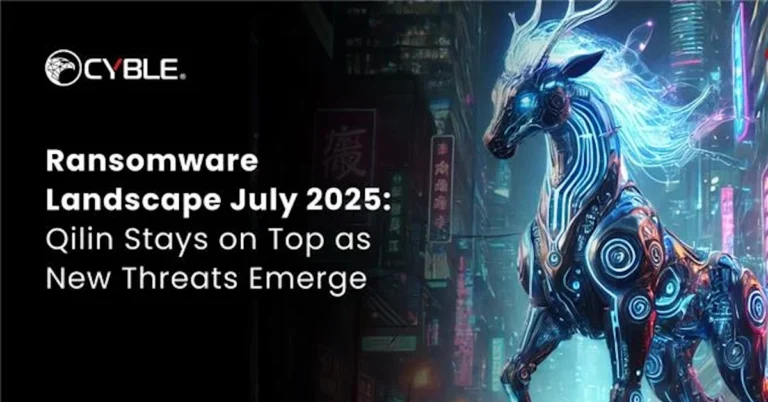Summary Points
- Qilin led ransomware activity for the third time in four months in July 2025, targeting 73 victims and contributing to the upward trend in global attacks, with the US being the most affected country.
- Critical infrastructure sectors and professional services were primary targets, with notable attacks on government, energy, telecommunications, and defense-related organizations.
- New ransomware groups and variants emerged, including BEAST, D4RK4RMY, and AiLock, showcasing evolving tactics like RaaS models, hybrid encryption, and cross-platform Linux attacks.
- Cybersecurity experts emphasize the importance of developing resilience through segmentation, zero trust, immutable backups, and comprehensive incident response planning to combat increasingly sophisticated ransomware threats.
What’s the Problem?
According to Cyble’s recent report, the ransomware landscape experienced a surge in activity during July 2025, with the hacker group Qilin once again leading attacks, making them the top offenders for the third time in four months after exploiting the downfall of RansomHub to target more victims. The data reveals that the United States suffered most from these attacks, with over 220 victims—significantly more than other regions—highlighting the country’s persistent vulnerability despite ongoing efforts to bolster cybersecurity. Notably, the attacks increasingly targeted critical sectors such as healthcare, construction, and government, with malicious groups like SafePay, Akira, and INC Ransom breaching high-value targets, including defense contractors and infrastructure service providers, risking national security and critical systems. This pattern underscores how cybercriminals are constantly innovating, deploying new ransomware variants—such as AiLock, DeadLock, and Gunra—and adopting advanced tactics like cross-platform Linux infections, to evade detection and maximize damage. The report, authored by Anna Ribeiro, emphasizes the importance of implementing robust cybersecurity measures, including network segmentation, backups, and incident response plans, as essential defenses in an ever-evolving threat landscape.
Critical Concerns
Recent Cyble data reveals that ransomware activity remains highly dynamic and increasingly sophisticated, with prolific groups like Qilin and INC Ransom continuing to lead attacks that target critical infrastructure, government, and private sectors across North America, Europe, and Asia. In July 2025, nearly 300 attacks were reported globally, driven by over 40 new variants and emerging threat groups employing advanced encryption techniques, Ransomware-as-a-Service models, and multi-platform capabilities—including Linux support—heightening the threat landscape. The impact is both financial and strategic: high-value breaches compromise supply chains, reveal sensitive government and corporate data, and threaten national security, while the proliferation of variants and tactics complicates detection and response efforts. As ransomware groups evolve with new technologies, attack methods, and geopolitical targets, organizations must prioritize cyber resilience strategies such as network segmentation, zero trust architecture, immutable backups, and comprehensive incident response plans to mitigate the risks posed by these relentless and adaptable cybercriminals.
Possible Next Steps
Understanding the urgency of timely remediation is crucial when confronting cyber threats like the recent report from Cyble, which highlights a US primary target suffering from 223 ransomware victims amid escalating attacks on critical infrastructure. Prompt action can prevent catastrophic damages, safeguard sensitive data, and ensure the continuity of essential services.
Mitigation Steps
- Incident Response: Activate and follow established incident response protocols immediately upon detection of an attack.
- Network Segmentation: Isolate infected systems to contain ransomware spread.
- Vulnerability Management: Regularly update and patch software to close security gaps.
- Data Backup: Maintain encrypted and offline backups of critical data for rapid recovery.
- User Training: Conduct ongoing security awareness programs to recognize and avoid phishing and malware.
- Threat Monitoring: Deploy advanced intrusion detection and prevention systems to identify malicious activities early.
- Access Controls: Enforce strict access controls and multi-factor authentication to limit unauthorized access.
- Collaboration: Share intelligence with cyber security agencies and industry partners to stay ahead of threats.
- Legal and Regulatory Compliance: Ensure all measures adhere to relevant laws to facilitate swift reporting and coordinated responses.
Explore More Security Insights
Discover cutting-edge developments in Emerging Tech and industry Insights.
Understand foundational security frameworks via NIST CSF on Wikipedia.
Disclaimer: The information provided may not always be accurate or up to date. Please do your own research, as the cybersecurity landscape evolves rapidly. Intended for secondary references purposes only.
Cyberattacks-V1

